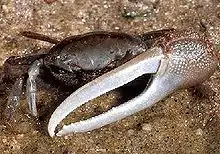Minuca pugnax
Minuca pugnax, commonly known as the Atlantic marsh fiddler crab, is a species of fiddler crab that lives on north-western shores of the Atlantic Ocean.
| Minuca pugnax | |
|---|---|
 | |
| Scientific classification | |
| Kingdom: | Animalia |
| Phylum: | Arthropoda |
| Subphylum: | Crustacea |
| Class: | Malacostraca |
| Order: | Decapoda |
| Infraorder: | Brachyura |
| Family: | Ocypodidae |
| Subfamily: | Gelasiminae |
| Tribe: | Minucini |
| Genus: | Minuca |
| Species: | M. pugnax |
| Binomial name | |
| Minuca pugnax | |
| Synonyms | |
| |
Distribution
Minuca pugnax is the most common species of fiddler crab on the east coast of the United States. Its natural range extends from Cape Cod to northern Florida.[2] In 2014, its northern limit was extended to Hampton, New Hampshire, as a result of a range expansion possibly due to climate change.[3]
Description
There is noticeable sexual dimorphism in Minuca pugnax. Although both males and females are olive-brown in color, males have a carapace width of 15–23 mm (0.59–0.91 in), and a patch of royal blue on the carapace, while females lack the blue patch and are only 13–18 mm (0.51–0.71 in) across the carapace.[2] In both sexes, the pereiopods (walking legs) have dark bands, and the eyestalks are narrow.[2] The most conspicuous difference is the form of the chelipeds (claw-bearing legs); in females, they are similar, while in males, one is greatly enlarged and colored yellow.[2]
Life cycle
The males use circular movements of their large cheliped to attract a mate. Mating occurs up to every two weeks, typically 4–5 days after the spring tides, over a period lasting from June to September.[2] It takes place in a burrow, after which the female will brood her eggs for 12–15 days before releasing the hatchling larvae on the high spring tides.[2] The larvae pass through five planktonic zoea and one megalopa stages before settling to the sea floor to molt into the adult form.[2] This process takes around 28 days. After one year, the crab reaches sexual maturity, and adult life span is typically 12–18 months.[2]
Taxonomic history
Minuca pugnax was first described by Sidney Irving Smith in 1870, as "Gelasimus pugnax". Its common names include "marsh fiddler crab",[2] "mud fiddler crab",[2] "Atlantic mud fiddler crab" and "Atlantic marsh fiddler crab".[4]
Minuca pugnax was formerly a member of the genus Uca, but in 2016 it was placed in the genus Minuca, a former subgenus of Uca.[5][6][7]
References
- Sammy De Grave; N. Dean Pentcheff; Shane T. Ahyong; et al. (2009). "A classification of living and fossil genera of decapod crustaceans" (PDF). Raffles Bulletin of Zoology. Suppl. 21: 1–109.
- Lauren L. Bergey (2007). Behavioral ecology and population biology in populations of fiddler crabs, Uca pugnax (Smith), on the New Jersey coast (Ph.D. thesis). Newark, New Jersey: Rutgers University. ISBN 978-0-549-37814-3.
- Johnson, David (2014). "Fiddler on the Roof: A northern range extension for the marsh fiddler crab Uca pugnax". Journal of Crustacean Biology. 34 (5): 671–673. doi:10.1163/1937240x-00002268.
- "Minuca pugnax". Fiddler Crabs. Retrieved 2020-11-16.
- Shih, Hsi-Te; Ng, Peter K. L.; Davie, Peter J. F.; Schubart, Christoph D.; et al. (2016). "Systematics of the family Ocypodidae Rafinesque, 1815 (Crustacea: Brachyura), based on phylogenetic relationships, with a reorganization of subfamily rankings and a review of the taxonomic status of Uca Leach, 1814, sensu lato and its subgenera". The Raffles Bulletin of Zoology. 64.
- Rosenberg, Michael S. (2019). "A fresh look at the biodiversity lexicon for fiddler crabs (Decapoda: Brachyura: Ocypodidae). Part 1: Taxonomy". Journal of Crustacean Biology. 39 (6).
- "WoRMS taxon details, Minuca pugnax (Smith, 1870)". World Register of Marine Species. Retrieved 2020-11-16.